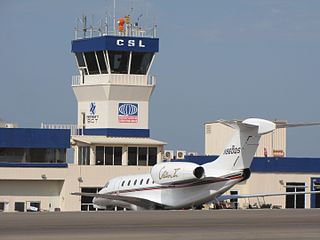
Semiconductor device fabrication is the process used to manufacture semiconductor devices, typically integrated circuits (ICs) such as computer processors, microcontrollers, and memory chips that are present in everyday electronic devices. It is a multiple-step photolithographic and physio-chemical process during which electronic circuits are gradually created on a wafer, typically made of pure single-crystal semiconducting material. Silicon is almost always used, but various compound semiconductors are used for specialized applications.
Radio-frequency identification (RFID) uses electromagnetic fields to automatically identify and track tags attached to objects. An RFID system consists of a tiny radio transponder, a radio receiver and transmitter. When triggered by an electromagnetic interrogation pulse from a nearby RFID reader device, the tag transmits digital data, usually an identifying inventory number, back to the reader. This number can be used to track inventory goods.

Cabo San Lucas, also known simply as Cabo, is a resort city at the southern tip of the Baja California peninsula, in the Mexican state of Baja California Sur. As of the 2020 Census, the population of the city was 202,694. Cabo San Lucas, together with the famous San José del Cabo are collectively known as Los Cabos. Together, they form a metropolitan area of 351,111 inhabitants.
Cyberware is a relatively new and unknown field. In science fiction circles, however, it is commonly known to mean the hardware or machine parts implanted in the human body and acting as an interface between the central nervous system and the computers or machinery connected to it.

Vega Baja is a town and municipality located on the coast of north central Puerto Rico. It is north of Morovis, east of Manatí, and west of Vega Alta. Vega Baja is spread over 14 barrios. The population of the municipality was 54,414 at the 2020 census. It is part of the San Juan–Caguas–Guaynabo metropolitan statistical area.

A microchip implant is an identifying integrated circuit placed under the skin of an animal. The chip, about the size of a large grain of rice, uses passive radio-frequency identification (RFID) technology, and is also known as a PIT tag. Standard pet microchips are typically 11–13 mm long and 2 mm in diameter.

Los Cabos International Airport is an international airport located in San José del Cabo, Baja California Sur, Mexico, serving as the main gateway to the popular tourist destination of the Los Cabos region on the Baja California Peninsula. Annually, the airport attracts millions of tourists, predominantly from the United States and Canada, with flights connecting to 30 U.S. cities and 11 Canadian cities. Major U.S. and Canadian airlines operate flights to and from Los Cabos, linking to their primary and secondary hubs.
Brain implants, often referred to as neural implants, are technological devices that connect directly to a biological subject's brain – usually placed on the surface of the brain, or attached to the brain's cortex. A common purpose of modern brain implants and the focus of much current research is establishing a biomedical prosthesis circumventing areas in the brain that have become dysfunctional after a stroke or other head injuries. This includes sensory substitution, e.g., in vision. Other brain implants are used in animal experiments simply to record brain activity for scientific reasons. Some brain implants involve creating interfaces between neural systems and computer chips. This work is part of a wider research field called brain–computer interfaces.
"The Implant" is the 59th episode of the sitcom Seinfeld. It is the 19th episode of the fourth season, and first aired on February 25, 1993 on NBC. The title refers to Elaine's belief that Jerry's girlfriend has breast implants, which is shaken when she accidentally grabs her breasts in a sauna incident. In a secondary plotline, George goes to a funeral for his girlfriend's aunt in hopes that it will advance their relationship. This episode popularized the term "double dipping" entering the public lexicon.

Six-Fours-les-Plages, is a commune in the Var department in the Provence-Alpes-Côte d'Azur region in southeastern France. Inhabitants of Six-Fours-les-Plages refer to themselves as "Six-Fournais".
Algorfa is a village in the Costa Blanca area of Spain, near the coast and surrounded by Mediterranean pine forest and citrus groves.

Rafic Hariri Stadium, also known as Al Manara Stadium or Nejmeh Stadium, is a multi-use stadium in the Manara district of Beirut, Lebanon. It is currently used mostly for football matches and serves as the home for Nejmeh. The stadium has a capacity of 5,000 spectators, as well as a VIP seats area that accommodates around 100 guests, a cafeteria, and a gymnasium.

In dentistry, crown refers to the anatomical area of teeth, usually covered by enamel. The crown is usually visible in the mouth after developing below the gingiva and then erupting into place. If part of the tooth gets chipped or broken, a dentist can apply an artificial crown. Artificial crowns are used most commonly to entirely cover a damaged tooth or to cover an implant. Bridges are also used to cover a space if one or more teeth is missing. They are cemented to natural teeth or implants surrounding the space where the tooth once stood. There are various materials that can be used including a type of cement or stainless steel. The cement crowns look like regular teeth while the stainless steel crowns are silver or gold.
Body hacking is the application of the hacker ethic in pursuit of enhancement or change to the body's functions through technological means, such as do-it-yourself cybernetic devices or by introducing biochemicals.

Cabo San Lucas International Airport is an international airport located in Cabo San Lucas, Baja California Sur, Mexico. It serves as a secondary airport to the popular tourist destination of the Los Cabos region on the Baja California Peninsula. In contrast to the larger Los Cabos International Airport situated approximately 32 kilometres (20 mi) to the north, Cabo San Lucas Airport primarily focuses on regional flights within western Mexico, as well as charter and commercial flights to the United States. It operates as the main hub for the regional airline Calafia Airlines. The airport also supports various activities in general and executive aviation, air taxi services, and flight training. It is the only privately-owned international airport in the country. The airport handled 45,178 passengers in 2021 and 40,714 passengers in 2022.
A visual prosthesis, often referred to as a bionic eye, is an experimental visual device intended to restore functional vision in those with partial or total blindness. Many devices have been developed, usually modeled on the cochlear implant or bionic ear devices, a type of neural prosthesis in use since the mid-1980s. The idea of using electrical current to provide sight dates back to the 18th century, discussed by Benjamin Franklin, Tiberius Cavallo, and Charles LeRoy.
Conrad Keven Chase was an American actor, singer-songwriter and public speaker.
A human microchip implant is any electronic device implanted subcutaneously (subdermally) usually via an injection. Examples include an identifying integrated circuit RFID device encased in silicate glass which is implanted in the body of a human being. This type of subdermal implant usually contains a unique ID number that can be linked to information contained in an external database, such as identity document, criminal record, medical history, medications, address book, and other potential uses.

Chips or crisps are often served with dipping sauces; together they are referred to as chips and dip. Chips used include potato chips, tortilla chips, corn chips, bean chips, vegetable chips, pita chips, plantain chips and others. Crackers are also sometimes used, as are crudités, which are whole or sliced raw vegetables. Various types of dips are used to accompany various types of chips. The dish may be served as a party dish, appetizer, hors d'oeuvre, or snack.

Neuralink Corp. is an American neurotechnology company that is developing implantable brain–computer interfaces (BCIs), based in Fremont, California, as of 2024. Founded by Elon Musk and a team of seven scientists and engineers, Neuralink was launched in 2016 and was first publicly reported in March 2017.











